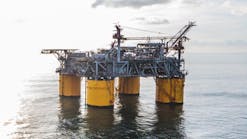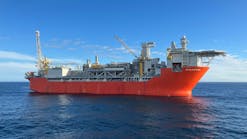Comparing Southern Cone Gas Consumption (13394 bytes)
Outlook For Gas Exports To Southern Cone Countries (13394 bytes)
Substantial gas reserves and projected huge demand growth in the region add up to a major emerging market for the gas industry in Latin America.
Along with the wave of privatization, demonopolization, deregulation, and economic reform sweeping the region, that means Latin America offers some of the best business opportunities for the petroleum industry today.
This consensus outlook emerged at the Latin American natural gas congress in Buenos Aires last month. The gas congress and its sister event, the Latin American refining congress, were sponsored by the Argentine Petroleum Institute.
These themes also emerged at the gas congress:
- With the exception of Argentina, Latin America's gas infrastructure is extremely underdeveloped.
- An early indicator of how Latin America's gas industry will evolve and grow will be how a flurry of current transnational projects to export gas among Southern Cone countries of South America will shake out. Success of some of these projects is crucial to integration of the Southern Cone (13394 bytes)'s gas industry and in turn hemispheric gas integration, a cherished goal of many in Latin American petroleum sectors.
- Not to be overlooked is the evolution of major supply, transportation, and distribution gas projects in northern South America, including Latin America's first liquefied natural gas export projects. These set the stage for gas industry integration in the northern countries of the continent.
- While the U.S. gas industry's evolution and recent deregulation successes offer lessons for Latin America's gas industry, there are enough differences to warrant caution in assuming the same approaches will work for Latin America.
GAS POTENTIAL
The outlook for Latin ,America's potential gas market growth is equaled only by that of Southeast Asia, said Total Austral's Benoit Charpentier.
Latin America's supply/demand outlook at first glance appears balanced, Charpentier noted. The region holds 5.5% of the world's proved gas reserves and accounts for 4.5% of the world's gas consumption (13394 bytes).
Venezuela and Mexico account for 75-80% of those reserves. Those two countries, along with Argentina, account for 75% of gas consumption in the region. Brazil, with 60% of the region's gross domestic product and 50% of South America's population, accounts for a mere 5% of the region's consumption, Charpentier noted.
Gas consumption in Latin America is concentrated mainly in the industrial and chemical sectors. These sectors combined account for about 50% of gas consumption in most countries in the region and more than 70% in Mexico, Trinidad and Tobago, Brazil, and Peru.
Residential consumption of natural gas in Latin America is very low by international standards, Charpentier said.
Only Argentina, with its extensive pipeline and local distribution networks, has a balanced gas demand portfolio. Gas represents 40% of primary energy demand in Argentina. That breaks out as 40% industrial, 33% power generation, and 24% residential. Of remaining demand, a strong market development program is under way to boost the natural gas share held by vehicular compressed natural gas to as much as 4%.
Even with a relatively mature gas market and Argentine gas demand growing at an impressive rate of 5%/year, there remains significant opportunity for gas market growth. Only 53% of Argentine homes are connected to gas service.
MEXICAN OUTLOOK
The Mexican gas sector has a lot of room to grow, said Bruce Burke, vice-president of Chem Systems Inc., Tarrytown, N.Y.
He noted that Mexican energy use is dominated by oil at about 74% in 1994. Natural gas use at about 24% is the only other major energy supply source.
Burke predicted total energy demand in Mexico will grow at a rate of about 1.9%/year and oil demand about 2.2%/year.
"Natural gas consumption has declined an average 1.5%/year during 1989-94," he said. "It is expected that this decline will stabilize and that gas use will increase in the future, achieving a 0.5%/year average growth.
"The primary reason for this recovery in demand is the stated intention of the Mexican government to address environmental issues in the major metropolitan centers."
Mexican gas reserves (13394 bytes) are mainly associated gas and can last almost 80 years at current rates of production, Burke said.
"Constraints on capital availability are expected to limit the ability of Mexico to develop new high risk, nonassociated reserves. Thus Mexico's future ability to increase gas supply is expected to be tied somewhat to increases in oil output."
Burke also noted gas pricing in Mexico has lately followed the free market push occurring elsewhere in North America.
"In practice, Mexican (gas) prices are linked, via transport costs, to pricing trends on the U.S. Gulf Coast," he said.
Chem Systems projects U.S. Gulf Coast gas prices to large industrial users will climb, in current dollars, to about $3.50/MMBTU by 2010.
"This level of pricing is expected to provide the required economic incentive to increase gas reserves and production over the forecast period."
MARKET POTENTIAL
South America's gas market is poised to grow significantly well into the next century, said David Nagel, senior vice- president, Amoco Corp. international gas marketing and business development.
Nagel estimated gas demand in South America will at least double by 2010 from current levels of 56 billion cu m/year.
"Argentina, Brazil, Chile, Colombia, and Venezuela are the primary markets, and there are a number of very interesting and challenging projects under way in this region to create and support the growth of these markets," Nagel said.
He noted that the northern coast of South America holds gas reserves totaling more than 4 trillion cu m, but the region's gas demand averages only 15 billion cu m/year.
This significant surplus creates a high potential for export projects, such as the Trinidad liquefied natural gas export project Amoco is undertaking along with British Gas plc, Cabot LNG, and National Gas Co. of Trinidad and Tobago. That project will target LNG exports to Spain and the U.S. He also noted that Venezuela is likely to participate in a regional gas export project early next century.
"In the Southern Cone, an estimated 1.3 trillion cu m of remaining reserves are dispersed throughout the country," Nagel said. "Large, underexplored areas exist in many countries, and new discoveries could significantly increase the reserve base."
He noted that only a small portion of natural gas demand is supplied by imports, with just one intercountry pipeline system on the continent, linking Bolivian gas supplies with northern Argentina.
Nagel expects that to change over time, citing two competing projects to deliver gas across the Andes to Chile, proposed pipelines to deliver gas from Bolivia and Northwest Argentina to Southeast Brazil, and the prospect of gas exported from South America's northern coast to Brazil.
"Privatization and liberalization of the gas and electric industries are driving the growth of the South American gas markets," he said. "Continued growth will be determined by the pace and breadth of these trends.
"As is true worldwide, the most effective way to facilitate development of large, capital intensive projects in the gas industry is to create and maintain a fiscal, commercial, and regulatory framework that provides investors with returns commensurate with the risks incurred."
MARKET LIBERALIZATION
Liberalization of markets is driving the current boom in Latin America's gas sector.
Charpentier ticked off these regulatory and legislative changes affecting the region's gas industry:
- Argentina has privatized transmission and distribution of natural gas in 1992 while deregulating markets. It followed that with privatization of state petroleum company YPF SA.
- Chile has embarked on privatization of its energy sector, essentially to benefit Chilean pension funds.
- Brazil is implementing its "flexibilization" policy, which essentially will end the petroleum monopolies of state owned Petroleo Brasileiro SA. Under this program, private capital is expected to begin entering Brazil's oil and gas sector during 1996-97.
- Privatization of Peru's state owned Petroleos del Peru SA is expected to occur by 1997.
- Colombia is making available to foreign companies concessions for gas distribution. It is part of a plan to develop a natural gas infrastructure in the northern part of the country at a cost of $3 billion - of which $1.1 billion will go for gas distribution - during the next 20 years.
- Venezuela has implemented attractive new profit sharing and service contracts involving private foreign and domestic companies in exploration and production and set the stage for a $5.5 billion LNG export project.
SOUTHERN CONE PROJECTS
Charpentier updated the outlook for the major gas projects pending in South America.
Heading the list in terms of imminence is the proposed $2 billion, 3,400 km gas pipeline from Bolivia to Brazil. It would have a capacity of 8-16 million cu m/day, five to seven times the current gas consumption of southern Brazil.
Firm contracts have been signed covering sale of 100 billion cu m of Bolivian gas to Brazil for 20 years beginning in 1997. Priority end users in Brazil for Bolivian gas are the industrial and power generation sectors.
Two competing projects have proposed to deliver Argentine gas across the Andes to Chile, linking gas fields in Argentina's Neuquen province with Santiago. Together the projects could supply 3-4 billion cu m/year starting in 1997. They will support Chile's efforts to increase the gas share of its energy mix by building gas fired power plants and converting coal fired power plants to gas, substituting gas for other fuels in industrial use, and expanding residential distribution.
The GasAndes project, which partly would use existing pipelines in Argentina, involves a 500 km, $350 million pipeline. GasAndes, led by Canada's NOVA Corp., has firm contracts in hand to transport the gas to Chile's main electric power producers Endesa, Chilgener, and Colbun.
The TransGas project involves a $700 million, 1,100 km gas pipeline from the Neuquen basin to Concepcion plus $400 million in associated upstream costs. It is being promoted by a group led by Tenneco, British Gas, and YPF and recently has encountered delays and loss of a key customer (OGJ, Nov. 6, Newsletter).
Farther on the horizon is a proposal to lay a 1,100 km, 2 billion cu m/year capacity pipeline from Bolivia to northern Chile at a cost of $1 billion. The project, the subject of a feasibility study, is intended to supply the El Escondido copper mines in northern Chile. Australia's BHP Petroleum Pty. Ltd. is leading the project in association with Chilean state oil company ENAP.
Other major Southern Cone gas projects in the offing include a possible pipeline link between Argentina and southern Brazil via Paraguay, one linking Peruvian and Bolivian gas fields with the Bolivia-Brazil pipeline, and one linking Argentine gas supplies with Uruguay that calls for a 200 km pipeline and underground storage sites in Uruguay with a possible spur to Buenos Aires.
NORTHERN SOUTH AMERICA
Of the gas projects along the northern coast of South America, the so-called gasification program of Colombia is the only one intended to meet domestic needs, Charpentier noted.
With little prospect of exporting its gas because of a surplus of the fuel in neighboring Venezuela and Trinidad and Tobago and great distances to other prospective markets, Colombia's government in 1993 approved plans to spend $3 billion during 20 years to develop a natural gas market in the central and southern portions of Colombia.
Plans call for laying 2,000 km of pipeline to supply the metropolitan areas of Bogota, Medellin, and Cali from fields in northern and Central Colombia, notably the huge gas reserves associated with Cusiana oil field and the Volcanera gas discovery.
The first phase of construction, calling for 500 km of pipeline from the northern fields to Bogota, is under way at a cost of $200 million.
In addition, Colombia's gasification program calls for developing 1.7 million kw of gas fired electrical power in 5 years, establishing a residential gas distribution network, and launching a vehicular CNG program.
Charpentier sees little likelihood of significant development of a domestic gas market in Venezuela in the near to medium term. An exception would be addition of some gas fired power capacity, which first calls for investment in developing a local distribution network.
Venezuela's gas prospects center on the Cristobal Colon LNG export project promoted by state owned Lagoven SA and a combine of foreign companies. The only thing that stands in the way of this project is development of a firm market for the LNG in North America, Charpentier said.
Trinidad and Tobago will continue to focus on maximizing value of its gas through exports rather than developing local markets. The country has gas reserves comparable to Colombia's but a population of only 1.5 million.
In addition to the proposed 3 million metric ton/year LNG export project - with 60% earmarked for the U.S. and 40% for Spain - Trinidad and Tobago is looking at other export projects fed by natural gas. These include urea/ammonia, methanol, and methyl tertiary butyl ether plants.
Charpentier expects Trinidad and Tobago to double gas production in 510 years, with more than 80% exported directly or in the feedstock equivalent for petrochemical products. Petro- chemicals currently absorb 40% of the country's gas production. Other leading industrial users of gas in Trinidad and Tobago are electrical power, aluminum, and cement.
LESSONS FROM NORTH AMERICA
Latin America's embryonic gas market is reminiscent of North America's decades ago, said Chris Spaulding, Amoco manager of Southern Cone gas projects.
Latin America's estimated gas demand of 3 tcf in 1992 compares with demand levels seen in the U.S. during the early 1940s.
The region is one of the world's fastest growing areas for gas demand, with South America alone expected to outstrip demand growth in North America fourfold to 2010, Spaulding said.
He contends the benefits of deregulation and market reform seen recently in North America can be transferred elsewhere.
"Before deregulation in the U.S., the gas market there was a very restricted environment," he said. "Gas sales occurred only at the interface between producers and transmission companies, between transmission companies and distribution companies, and finally to end users.
"This did not promote competition because buyers' and sellers' choices were limited."
In addition, Spaulding said, the regulatory environment in the U.S. gas market forced producers' prices below replacement value but stimulated demand. That led to severe shortages in the mid-1970s.
He noted that under the current, open regulatory environment in the U.S.:
- Sellers now have access to many buyers, and buyers have access to many sellers.
- There has been a substantial improvement in the supply/demand balance.
- Inefficiencies and unnecessary costs have been driven out of the system.
- There has been improved growth rates, with the outlook for still more growth.
Those developments suggest important lessons for the gas industry in the rest of the world - positive and negative, Spaulding said.
A critical point to remember is that the highly developed, mature aspect of gas markets in the U.S. allows players to compete across the system there. For the long term success of gas markets in South America, industry must expand beyond the very localized - except for Bolivia and Argentina - infrastructure.
North American gas market drivers also exist and provide opportunity for growth in South America, Spaulding said. These include economic growth, new technologies, energy policies favoring gas, regulatory and financial restructuring, environmen- tal concerns, a healthy supply/demand balance, evolution of regional markets, and a favorable price for gas compared with other fuels. In addition, market drivers in South America include liberalization and privatization trends, increased productive capacity relative to demand, and growth in demand for gas for electrical power generation.
An understanding of these drivers and gas flow dynamics in South America and the Caribbean is critical to success in South America's gas market by 2010, Spaulding said.
But most critical, he contends, is the assumption that "reforms will continue to drive the market, and private investors will continue to be allowed to participate throughout the gas value chain."
Spaulding said there must be a willingness among governments to create and support a viable fiscal and regulatory framework. The goal is to allow investors to participate in the gas value chain in a way that facilitates progress in capital intensive projects. Such projects are needed to create and sustain growth in gas demand.
Spaulding said, "For the investor, his opportunity to participate in the gas value chain represents an opportunity to protect his investment against volatility in profits, an element of risk inherent in the gas business.
"Finally, there will be an increasing need for partnerships and joint ventures to take the lead on these projects because of capital constraints. As a result, participation of government and state owned players will continue to be an absolute necessity if gas markets are to develop in an effective manner."


